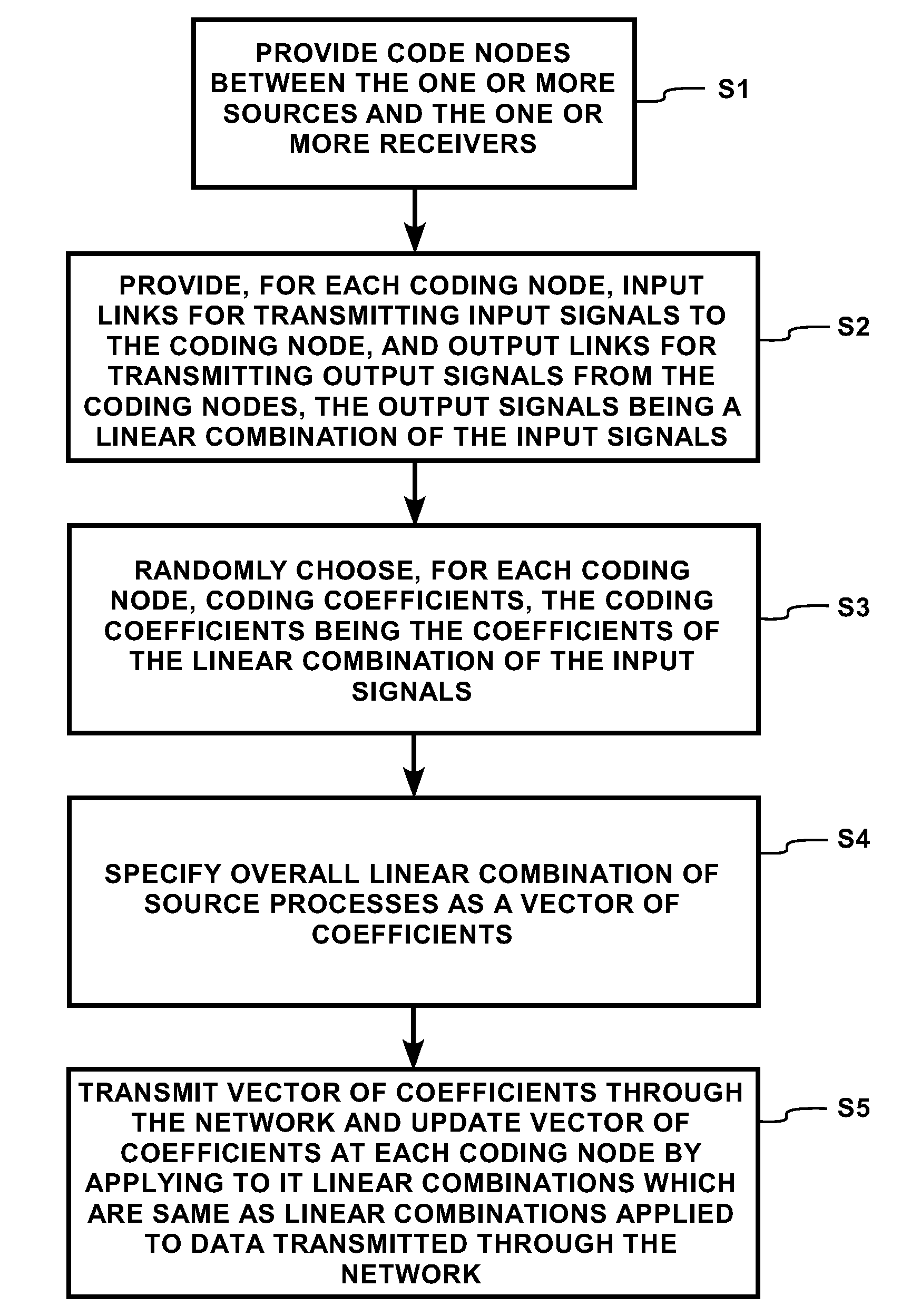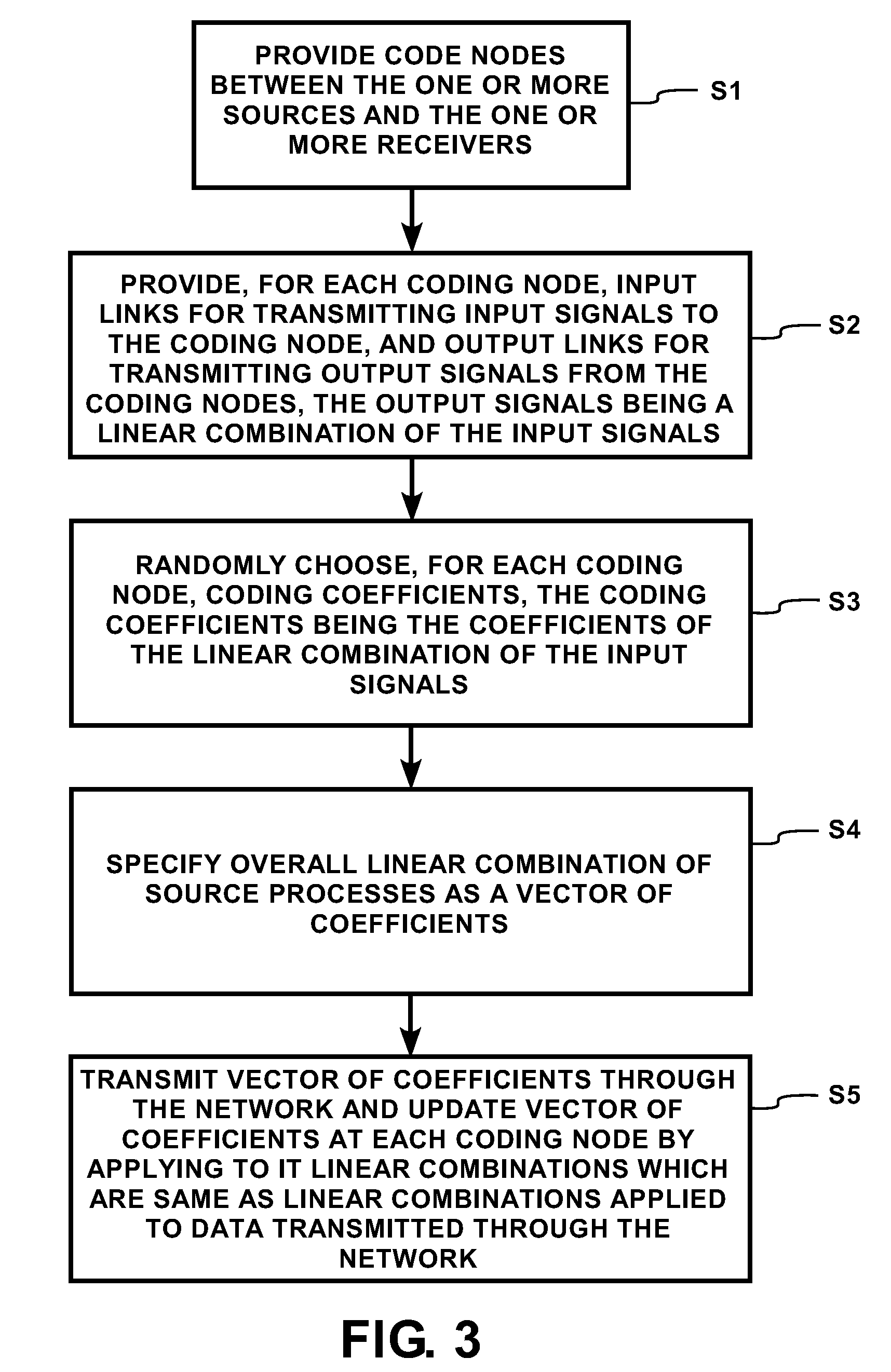Randomized distributed network coding
a distributed network and coding technology, applied in the field of random distributed network coding, can solve problems such as multicast connection, and achieve the effects of reducing the required transmission rate, maximal robustness, and full flexibility
- Summary
- Abstract
- Description
- Claims
- Application Information
AI Technical Summary
Benefits of technology
Problems solved by technology
Method used
Image
Examples
first embodiment
[0019]the present disclosure makes reference to acyclic delay-free networks, as also generally shown in Annex A1 and more specifically in Annex A2.
[0020]FIGS. 1 and 2 show two examples of acyclic networks having source nodes S and receiver nodes R, and a plurality of intermediate nodes C. The intermediate nodes allow communication of source processes to each receiver node R. The intermediate nodes (see node 10, for example) have input links I and output links O. The input links I communicate input signals to the node 10, while the output links O communicate or transmit output signals from the intermediate nodes.
[0021]Differently from what shown in the prior art, the present disclosure considers an approach, in which network nodes independently and randomly choose code coefficients from some finite field and transmit on each outgoing link a linear combination of incoming signals, specified by the independently and randomly chosen code coefficients from some finite field. For a detail...
second embodiment
[0031] these results can be generalized to networks with cycles and delays. Reference can be made to Annex A3.
[0032]Going from the acyclic delay-free case to the case with cycles and delay, the scalar coefficients of the linear combinations become polynomials in a delay variable. The number of terms of the polynomials to be sent, and the memory required at the receivers, depend on the number of links involved in cycles (memory registers) in the network. For less frequently changing networks, instead of sending coefficient vectors through the network, a phase can be provided in which the sources take turns to each send a unit impulse through the network. See section 2 of Annex A3.
[0033]In this second embodiment, similar results to those shown with reference to the first embodiment are obtained. See Theorems 1-4 in Section 3 of Annex A3 and related proof in Section 4 of Annex A3.
[0034]In particular, bounds for the success probability of distributed randomized network coding for multi-...
third embodiment
[0036] these results can be generalized to arbitrarily correlated sources. Reference can be made to Annex A4.
[0037]In this third embodiment, randomized linear network coding is done over vectors of bits in the finite field of size two. This can be treated similarly to the first two embodiments by conceptually extending each source into multiple sources and each link into multiple links, such that each new source and link corresponds to one bit in the code vectors. Randomized coding and transmission of code coefficients to the receivers can then be done similarly to the previous embodiments. See section II of Annex A4.
[0038]Similar results to those shown with reference to the first two embodiments are obtained. In particular, a bound on the error probability for distributed randomized linear coding of arbitrarily correlated sources over an arbitrary network is given, which decreases exponentially with the number of codeword bits. See Theorem 1 in Section III of Annex A4.
[0039]FIG. 3 ...
PUM
 Login to View More
Login to View More Abstract
Description
Claims
Application Information
 Login to View More
Login to View More - R&D
- Intellectual Property
- Life Sciences
- Materials
- Tech Scout
- Unparalleled Data Quality
- Higher Quality Content
- 60% Fewer Hallucinations
Browse by: Latest US Patents, China's latest patents, Technical Efficacy Thesaurus, Application Domain, Technology Topic, Popular Technical Reports.
© 2025 PatSnap. All rights reserved.Legal|Privacy policy|Modern Slavery Act Transparency Statement|Sitemap|About US| Contact US: help@patsnap.com



